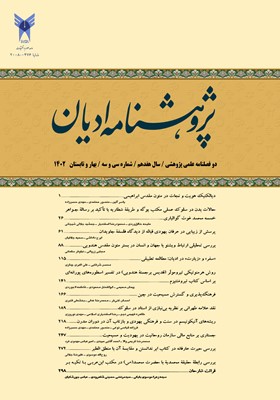بررسی حیرت عارفانه در کتاب ابر ندانستن و مقایسه آن با منطقالطیر
محورهای موضوعی : مسیحیتروح اله موسوی 1 * , علیرضا جلالی 2
1 - ادیان و عرفان، دانشگاه پیام نور مرکز اصفهان
2 - ادیان وعرفان.دانشکده الهیات وعلوم اسلامی. دانشگاه پیام نور. ایران
کلید واژه: تأمّل, ابر فراموشی, منطقالطیر, عطار, ابر ندانستن, حیرت,
چکیده مقاله :
ناتوانی عقل در وصول به ذات باریتعالی و حیرت در برابر آن، از مفاهیم مشترک عرفان اسلامی و مسیحی است. کتاب کلاسیک ابر ندانستن که به تدبیر یکی از عارفان ناشناس مسیحی در قرن چهاردهم میلادی به نگارش درآمده، سیر و سلوک انسان عارف را، به حرکت از خویشتن بهسوی خداوند در ابری از تاریکی و جهالت تعبیر مینماید؛ در این سیر، سالک با قرار دادن ابری از فراموشی میان خویش و کل هستی، با پیکان تیز عشق بهسوی حقیقت متعال پرواز میکند. نوشتار حاضر به تحلیل مضامین محوری این کتاب، بهویژه ابر ندانستن(The Cloud of Unknowing) و ابر فراموشی(The Cloud of Forgetting) میپردازد و به منظور ژرفا بخشیدن به این تحلیل، آن را با نمونه ای از عرفان ایرانی-اسلامی، منطقالطیر عطار مقایسه مینماید. از این رهگذر، ضمن کوشش در درک منظر عارف انگلیسی، دیدگاه مشترک میان این دو عارف تأثیرگذار بررسی میگردد. فرجام آنکه، عطار نیشابوری، اشتیاق آدمی برای وصول به حضرت حق را گذشتن از بادیهها و بیابانهای سوزان و سرانجام رسیدن به مرتبه حیرت میداند و عارف مسیحیِ زیسته در میدلَندزِ پُربارانِ انگلستان، این وصول را پرواز و گذر از میان انبوه ابرهای تیره ندانستن میداند.
The inability of the intellect to reach the essence of transcendence and bewilderment against it, is one of the common concepts of Islamic and Christian mysticism. The Cloud of Unknowing, written by an Christian mystic interprets the path of a mystic as moving towards God in a cloud of darkness, ignorance, and bewilderment; In this journey, the seeker flies towards the transcendent truth with a sharp arrow of love, placing a cloud of forgetting between himself and the whole universe. The essay deals with the central themes of this book, especially The Cloud of Unknowing and The Cloud of Forgetting, and in order to deepen this analysis, it uses an example of Iranian mysticism, that is, The Conference of the Birds (Manṭiq-uṭ-Ṭayr) by Farid ud-Din Attar. In this way, while trying to understand the perspective of the English mystic, the common point of views between these two prominent mystics is analyzed.Attar considers man's desire to Join God as passing through the burning deserts and valleys and finally reaching the level of bewilderment (hayra), while the Christian mystic, who lived in the rainy Midlands of England, sees this attainment as flying through the clouds of bewilderment, darkness and ignorance.
_||_

